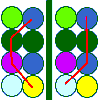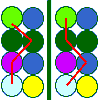
Dog Breeding and Placement Issues

I'm not going to discuss all the ins and outs of inbreeding here. I'm merely going to respond to the occasional panicked person who writes "the father just bred to the daughter, what can happen?." The same answer will apply whether it is father/daughter mother/son sister/brother. What can happen will depend on the genetics of the pair.
Inbreeding, even incestuous inbreeding, is not "bad", but it is risky. Before we understood the nature of genetics it was merely observed that extensive inbreeding created some bad results. A perfectly sensible rule is that if doing something causes bad results stop doing it. However, you get better decision making if you can learn more specifically what went wrong. And in the case of bad results from inbreeding that went wrong is mostly (a) not knowing to keep good records and (b) not understanding genetics.
I cannot tell you how risky your particular inbreeding is. I can tell you what information you need to have to find out. I can tell you that if there are good records on the qualities and health of the other dogs in the line you will have a better chance of figuring out the risks than if you know little about the background.
Let's start with a quick genetics review. Be patient, we'll get there. The qualities that are passed to offspring are passed through genes. Genes are the set of instructions that determine such characteristics as eye color, size, even temperament. For most cells the gene is composed of two sets of instructions. The set can be matched, or unmatched.

When an egg or sperm is created they carry
half of the genetic material of the parent. But that half isn't like splitting a pie. It doesn't split down some imaginary middle, of the entire strand, even if some explanations show it that way.

Each gene is split but it can combine with the others in many ways.


Most people are aware that genes come in pairs.
But most people also some serious mistakes in their understanding. Getting rid of this mistaken thinking is important in understanding the risks of inbreeding in general, and incestuous inbreeding in particular.
Here are some common misunderstandings:
(1) Thinking of recessive genes as "bad" and dominant ones as "good."
That is wrong. Let me give an example. The same results might be thought of as good in one case, and bad in another. Prick ears are wanted in the German Shepherd Dog, unwanted in the Collie.
(2) Thinking it is "better" to have no recessive genes.
A frequent argument in fear of inbreeding is that it increases the rate of recessive characteristics. But dominance is not always healthier. The coat pattern "merle" is dominant. The pattern is common in many breeds although sometimes it goes by different names. In the dachshund, for example, it is called "dapple." If you breed together two dogs each with a merle coat pattern you stand a good chance of getting puppies that deaf, blind or both.
(3) Thinking there are only dominant and recessive genes.
Genes interact, and some have "incomplete" dominance. The exact results depend upon this interaction, not just the influence of a single gene. That merle gene is a good example. If only one gene is active for the coat pattern, that is fine, if none are active for that pattern that too is fine, but if both genes are active to the pattern, that leads to problems. And that is because, as mysterious as it may seem, the way coat patterns are created also influence the development of structures in the eyes and ears.
(3) And finally forgetting about that second gene pair, the one they can't see by looking at the dog.
It is that second set that results the unexpected effects, and that is seen more in incest breeding than in completely unrelated breeding. What you
see is
not necessarily what you get. It is the
unknown in this hidden set that creates the fears, and rightly so.
Remember that we mentioned that genes come in pairs. Sometimes the pairs match (called homozygous) and sometimes they don't (heterozygous). Inbreeding does not cause genetic problems. But inbreeding does increase the chances of creating matched pairs. And if the particular pair that matches up is recessive then you may see in the puppies something you did not see in either parent. It could be a good thing or a bad thing. Incest breeding is like breeding with a magnifier. It makes whatever is there bigger, and happen more often. Incest inbreeding risks get bigger with each generation. The first time it happens it is less risky than if there is more incest breeding in the background.
You learn about how big a risk an incest breeding by taking what you know of each parent's background as a clue to the risk of a unfavorable match up. If you do not have information on the background you cannot assess the risks. However, if you do not have information on the background the risks that the dog was not bred with knowledge about genetic issues is very high. And remember where we started out. Incest breeding has a reputation for being a bad thing because bad results occurred. There was no understanding of the genetics involved. The bottom line is that incest breeding is not automatically bad, but it has the potential for bad results, and the less you know, the bigger the risk. Some great resources on genetics can be found on the Glossary of Genetic Terms.
So ... the big question ... what should you do? If these are your dogs we are talking about, and their mating you are concerned about, start with doing a better job of management. Talk to your vet about terminating the pregancy. To do right by any puppies you need to understand more than you do now. And you need to get more complete information on canine genetics than appears here. The book Control Of Canine Genetic Diseases by George Padgett does a good job of explaining. Please make an honest effort to separate your love of your dog from the qualities of your dog as breeding material. You should be proud of your dog, and very attached. But if all it took is to have a wonderful dog we wouldn't be killing so many in shelters. The lives of dogs depend upon you making good choices.
And if a puppy you bought or planned on buying is the result of an incest breeding (mother and son, brother and sister, father and daughter)? Don't panic. Is the breeder testing for genetic health issues? Is the breeder recording the results of those tests with an independent registry such as OFA? Did the breeder provide you with a five generation pedigree? Are many or most of those dogs tested? Testing isn't the only important thing to look for in a breeder. But it is a guide for you to separate out the knowledgeable breeder from the unknowledgeable. No testing is a bad sign. Essentially the fact of an incest breeding alone is no cause for complaint. Breeding with out knowledge is a cause for complaint.
For more information on breeding related health issues see Breeder Resources.
Research, consider and explore the issues with these links:

Visit the DogPlay Mall. Great dog tee shirts, sweatshirts, and tracksuits. Also mugs, magnets, buttons, stickers and more. Special sections for rescue dogs, anti-breed specific legislation, herding and dog agility. |
|||
 |
|||
Xylitol risk to your dog |
|||
Copyright © 1999-2003, Diane Blackman Created: January 15, 1999 Updated February 27, 2009
Help with Contacting DogPlay
For information on linking and other uses of this material see the copyright
page.
Disclaimer and Privacy Policy
Unauthorized copy discovery is enabled
Help About Partners Listing Home